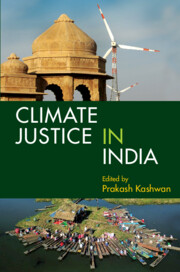Book contents
- Frontmatter
- Contents
- List of Poems and Artworks
- List of Tables
- List of Figures
- List of Abbreviations
- Preface and Acknowledgements
- 1 Introduction: Climate Justice in India
- 2 Urban Climate Justice in India
- 3 How Just and Democratic Is India’s Solar Energy Transition?: An Analysis of State Solar Policies in India
- 4 Extractive Regimes in the Coal Heartlands of India: Difficult Questions for a Just Energy Transition
- 5 Climate Justice Implications of the Relationship between Economic Inequality and Carbon Emissions in India
- 6 Climate Action Plans and Justice in India
- 7 Social Mobilizations for Climate Action and Climate Justice in India
- 8 Reimagining Climate Justice as Caste Justice
- 9 Intersectional Water Justice in India: At the Confluence of Gender, Caste, and Climate Change
- 10 Realizing Climate Justice through Agroecology and Women’s Collective Land Rights
- 11 Conclusion: Pathways to Policies and Praxis of Climate Justice in India
- About the Editor and Contributors
- About the Poets and Artists
- Index
Preface and Acknowledgements
Published online by Cambridge University Press: 03 November 2022
- Frontmatter
- Contents
- List of Poems and Artworks
- List of Tables
- List of Figures
- List of Abbreviations
- Preface and Acknowledgements
- 1 Introduction: Climate Justice in India
- 2 Urban Climate Justice in India
- 3 How Just and Democratic Is India’s Solar Energy Transition?: An Analysis of State Solar Policies in India
- 4 Extractive Regimes in the Coal Heartlands of India: Difficult Questions for a Just Energy Transition
- 5 Climate Justice Implications of the Relationship between Economic Inequality and Carbon Emissions in India
- 6 Climate Action Plans and Justice in India
- 7 Social Mobilizations for Climate Action and Climate Justice in India
- 8 Reimagining Climate Justice as Caste Justice
- 9 Intersectional Water Justice in India: At the Confluence of Gender, Caste, and Climate Change
- 10 Realizing Climate Justice through Agroecology and Women’s Collective Land Rights
- 11 Conclusion: Pathways to Policies and Praxis of Climate Justice in India
- About the Editor and Contributors
- About the Poets and Artists
- Index
Summary
My ongoing engagements with international and national debates on climate justice are a result of an intellectual journey over the past two decades that has brought me time and again to the complex intersections of environmental protection and social justice. Market-based solutions became the backbone of ostensible global responses to climate change at the United Nations Climate Change Conference held in Bali in December 2007. The sense of excitement among environmental economists then is difficult to describe from where we are today. However, to those of us who had spent time in the field, this euphoria was evidently and grossly misplaced. The journey that marketbased solutions would have to take, from Bali to places like Bastar in Chhattisgarh, where they would be eventually implemented, is not paved with the freedom of choice that pro-market advocates like to celebrate.
Markets are designed to facilitate the accumulation of surplus in the hands of those who can channel it higher up in the ‘food chain’. In most cases, the market ecosystem is essentially a centralizing force and does not work for the poor and marginalized. Unfortunately, this argument often falls through the cracks due to the lack of interdisciplinary work that is needed to produce knowledge that may help inform public debates on these complex questions. The market-based solutions institutionalized at the Bali climate conference, especially carbon offsets and carbon emissions trading, have proven to be colossal failures.
Perhaps even more embarrassingly, the advocates of market-based climate solutions lost the battle of ideologies to right-wing reactionary forces. Even in the supposedly knowledge-driven market economies of the Global North, ultra-conservatives have been successful in labelling neoliberal policies, such as offsets and cap-and-trade policies, as part of ‘the radical Left's progressive wish list’. This is not surprising to many on the left but this also offers much food for thought for students of policy analysis, who focus rather narrowly on coming up with ‘efficient solutions’. While smart analyses can be helpful, the belief that such analyses are sufficient to drive policy change has proven to be a chimera. This is why it is necessary to cultivate a strong awareness of the extent to which the beneficiaries of the status quo use their political and economic power to thwart sensible debates on the unprecedented environmental and social crises.
- Type
- Chapter
- Information
- Climate Justice in India , pp. xvii - xxPublisher: Cambridge University PressPrint publication year: 2025
- Creative Commons
- This content is Open Access and distributed under the terms of the Creative Commons Attribution licence CC-BY-NC 4.0 https://creativecommons.org/cclicenses/

